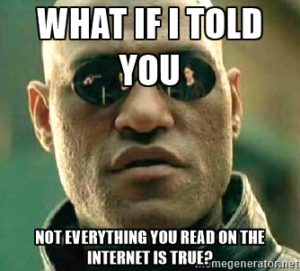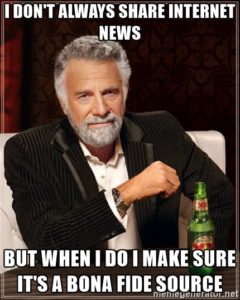Southern Fried Science has at the forefront of trying to debunk fake news, such as faux documentaries about mermaids or giant sharks. In their article “Fish tales: combating fake science in the popular media” Andrew Thaler and David Shiffman asked that:
“scientists familiarize themselves with common sources of misinformation within their field, so that they can be better able to respond quickly when factually inaccurate content begins to spread”

Circulation of fake news news is arguably on the rise. In particular, the plethora of “fake news” during the recent US election was unprecedented. A lot of partisan websites, in particular, were sharing false material. A review conducted by Buzzfeed found that both sides of the election shared false information – although conservative sites shared roughly twice as much false material than liberal sites. During the election much fake news was specifically produced in Macedonia and Russia, to either raise click rates, or potentially to influence voters (see this segment by Samantha Bee on Russian trolling). The fake sites were too frequently shared by viewers uncritically, especially by those using Facebook.
The rise in sharing of fake news was particularly influenced by Facebook changing the way it shared sites of potential interest to members. There had been moves to reduce the amount of fake news and hoax stories, with trending news was curated by human reviewers that separated fact from fiction. However, there were protests that conservative news sources were being restricted and the human curating team was fired. The system became fully automated and algorithms were ‘loosened’. This ultimately led to a much high rate of fake news slipping into people’s news feeds. Although, as I was working on this article, both Google and Facebook have announced that they are both going to take measures to restrict the spread of fake news, to some extent or other.
However, regardless of these changes, there is still much false information available online, and a large segment of the public is unaware of what constitutes a reliable source of information … and what is not. As any teacher will tell you, a too large proportion of students, whether at high school or university, assume that because something is on the internet it must be true (see this SFS article on the need to teach about bona fide sources of information at schools).
Thankfully, Dr. Melissa Zimbars (a Professor studying communication and the media at Merrimack College) has curated a list of websites that frequently contain false information- whether it be deliberate and malicious, indirectly through poor fact-checking, or through the sites being “satirical”. The list is provide here (thanks to Dr Zimbar’s creative comments license). This will make it much easier for us all to separate the factual from the fake, when it comes to news, regardless of which side of the political fence you are on.
Fans of The Onion will note that it is listed (because of satire), and might be scratching their heads thinking “surely everyone realizes that Onion stories are not true?!” From personal experience, sadly not. The number of people who thought that SeaWorld really did put killer whales in plastic bags when they were cleaning the tanks (see this and this for evidence) was far too high!
False Misleading or Satirical News Sources
(FYI for those of you with Google Chrome – here’s an extension that will give you a ‘pop up’ warning if you try to access a page on this list)
This List is was produced by Melissa Zimdars (© 2016 ) in the work ‘False, Misleading, Clickbait-y, and Satirical “News” Sources‘ which was made available under a Creative Commons
Attribution 4.0 International License. To view a copy of this license, visit

